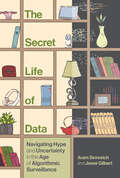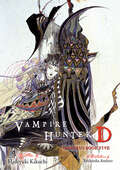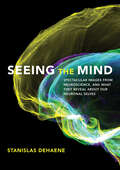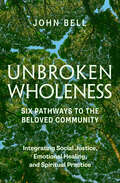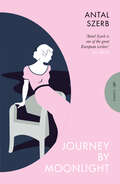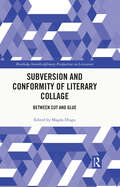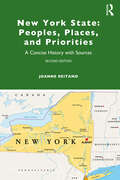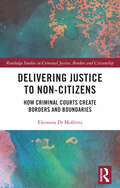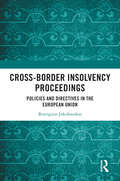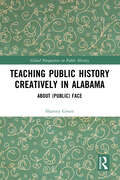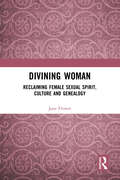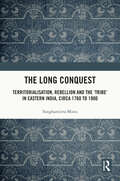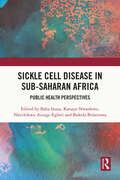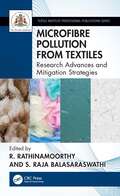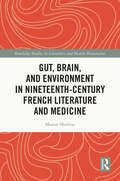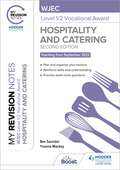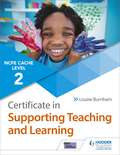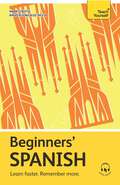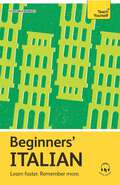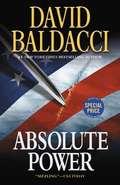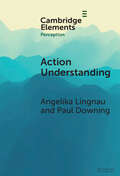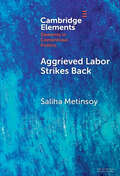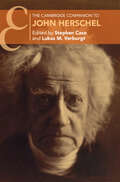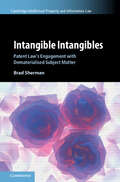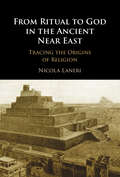- Table View
- List View
The Secret Life of Data: Navigating Hype and Uncertainty in the Age of Algorithmic Surveillance (The Information Society Series)
by Aram Sinnreich Jesse GilbertHow data surveillance, digital forensics, and generative AI pose new long-term threats and opportunities—and how we can use them to make better decisions in the face of technological uncertainty.In The Secret Life of Data, Aram Sinnreich and Jesse Gilbert explore the many unpredictable, and often surprising, ways in which data surveillance, AI, and the constant presence of algorithms impact our culture and society in the age of global networks. The authors build on this basic premise: no matter what form data takes, and what purpose we think it&’s being used for, data will always have a secret life. How this data will be used, by other people in other times and places, has profound implications for every aspect of our lives—from our intimate relationships to our professional lives to our political systems.With the secret uses of data in mind, Sinnreich and Gilbert interview dozens of experts to explore a broad range of scenarios and contexts—from the playful to the profound to the problematic. Unlike most books about data and society that focus on the short-term effects of our immense data usage, The Secret Life of Data focuses primarily on the long-term consequences of humanity&’s recent rush toward digitizing, storing, and analyzing every piece of data about ourselves and the world we live in. The authors advocate for &“slow fixes&” regarding our relationship to data, such as creating new laws and regulations, ethics and aesthetics, and models of production for our data-fied society.Cutting through the hype and hopelessness that so often inform discussions of data and society, The Secret Life of Data clearly and straightforwardly demonstrates how readers can play an active part in shaping how digital technology influences their lives and the world at large.
Vampire Hunter D Omnibus: Book Five
by Hideyuki KikuchiA new omnibus collecting volumes thirteen, fourteen, and fifteen of the Vampire Hunter D horror novel series!The hunt continues in the bizarre far future of 12,090 A.D, where the immortal vampire lords who were the only winners of mankind&’s nuclear war still oppress the human survivors who have pushed the blood-drinking fiends back to the lawless Frontier. Yet humanity too remains as quick as ever to prey upon itself, and where the law can&’t bring safety or justice, the crescent blade of D will—assuming you meet the half-vampire wanderer&’s price!Vampire Hunter D Omnibus Book Five collects in full two different multi-part novels!Twin-Shadowed Knight is a story in two parts—most apt, as the D&’s investigation into a vampire&’s dying words leads to a sorcery that splits the Hunter himself into two beings…the second D, full of passion, hunger, and carnal desire!Then, the three-part Dark Road brings triple the thrill, as D crosses over the southern border into the realm of General Gaskell. No ordinary vampire noble, this immortal warlord survived his supposed death under the sun to command the loyalty of a veritable army of the undead, who have been given their silent marching orders—eliminate D! The Vampire Hunter D Omnibus Book Five collects volumes 13, 14, and 15 in author Hideyuki Kikuchi&’s adventure horror series: Twin-Shadowed Knight Parts One and Two, Dark Road Parts One and Two, and Dark Road Part Three. Illustrated by Final Fantasy artist Yoshitaka Amano, the legend of D endures!
Seeing the Mind: Spectacular Images from Neuroscience, and What They Reveal about Our Neuronal Selves
by Stanislas DehaeneA lavishly illustrated and accessibly explained deep dive into the major new findings from cognitive neuroscience.Who are we? To this age-old question, contemporary neuroscience gives a simple answer: we are exquisite neuronal machines. Each of our dreams, thoughts, and feelings arises from a pattern of activity in our brain. In Stanislas Dehaene&’s Seeing the Mind, we learn not only that the mind maps onto the brain, but that it is just a complex electrical motif on the tapestry of our neurons. In this richly illustrated and highly accessible book, Dehaene uses the power of brain images to tell the story of centuries-old efforts to understand who we are, and how it is possible that our thoughts emerge from just three pounds of flesh. Seeing the Mind is divided into one hundred topics, each described by a spectacular full-page color image and, on the facing page, a brief text that explains what this image means and why it matters. By weaving together images and text, the book brings readers into the intimacy of their own brains. As Dehaene explains, &“All the gorgeous biological processes that you are about to discover are taking place, right now, inside your own brain.&” A modern cabinet of curiosities, Seeing the Mind is an intriguing and memorable read that will astonish readers with a direct, face-to-face meeting with themselves—and with the material stuff of their thoughts and dreams.
UNBROKEN WHOLENESS: Integrating Social Justice, Emotional Healing, and Spiritual Practice
by John Bell&“A holistic vision breathtaking in scope.&”—Frances Moore LappéDistilling a lifetime&’s insights on the triangle of healing emotional pain, social justice work, and spiritual growth, veteran activist and educator John Bell shares personal stories and reflective practices to help us on our path of personal and collective transformationUnbroken Wholeness brings an integrated lens of social justice, trauma healing, and spiritual practice to the work we do in the world and the pressing concerns of our times.Collectively, these writings help us access a view of the world as unbroken, even in the face of obvious suffering and disharmony. With searching questions and easy-to-follow practices, Unbroken Wholeness offers a way for activists to apply mindfulness and insight to bring about healing for seemingly intractable social divisions. &“Skillfully handling our emotional pain about the world while cultivating a joyful and kind heart helps us navigate the troubled waters of our life,&” says John Bell. Continuing the peace work of his teacher, the Vietnamese social activist and Zen master Thich Nhat Hanh, John Bell brings forward the importance of cultivating a practical yet visionary, ennobling view of humankind when engaging in the &“mud&” of daily difficulties that gives rise to the lotus of an enlightened, compassionate heart.
Journey by Moonlight (Pushkin Press Classics)
by Antal SzerbAn early-twentieth-century classic — the turbulent, dreamlike story of a businessman torn between middle-class respectability and sensational bohemia&“No one who has read it has failed to love it.&” — Nicholas LezardMihály and Erzsi are on honeymoon in Italy. Mihály has recently joined the respectable family firm in Budapest, but as his gaze passes over the mysterious back-alleys of Venice, memories of his bohemian past reawaken his old desire to wander.When bride and groom become separated at a provincial train station, Mihály embarks on a chaotic and bizarre journey that leads him finally to Rome, where he must reckon with both his past and his future. In this intoxicating and satirical masterpiece, Szerb takes us deep into the conflicting desires of marriage and shows how adulthood can reverberate endlessly with the ache of youth.
Subversion and Conformity of Literary Collage: Between Cut and Glue (Routledge Interdisciplinary Perspectives on Literature)
by Magda DraguSubversion and Conformity of Literary Collage: Between Cut and Glue fills a gap in the current scholarship on literary collage, by addressing how different the interpretations of the concept are, depending on the author who uses the concept and the material and writers surveyed. The book studies writers who employed literary collage during the twentieth and twenty-first centuries, some whose works have been intensely analyzed from this perspective (William S. Burroughs and Walter Benjamin), but also some whose collage-writing style has recently been investigated by writers, being usually placed under the umbrella term of artist books (Stelio Maria Martini).
New York State: A Concise History with Sources
by Joanne ReitanoNow in its second edition, New York State: Peoples, Places, and Priorities is an accessibly written book that explores the ever-shifting dynamics of New York State history in a single volume.The text is organized both chronologically and topically, balancing political, economic, social, and cultural history. It discusses key figures, groups, movements, and controversies, upstate and downstate. Each chapter is divided into teachable, digestible sections that examine the major developments and challenges of that period, with timelines and lists of online resources to aid student understanding. The new edition brings New York State’s history into the present with coverage of recent political and economic developments, the Covid-19 pandemic, immigration, and global warming. Throughout the book, material was added concerning the American Revolution, the Civil War, women’s rights, and environmental justice. Artwork, maps, charts, and textboxes illuminate the state’s rich history. Analytical questions accompanying figures and texts encourage deeper engagement with the past.Designed for undergraduates, this book is a concise and updated account of New York State’s history over the centuries, with a wealth of resources to benefit students and instructors alike.
Delivering Justice to Non-Citizens: How Criminal Courts Create Borders and Boundaries (Routledge Studies in Criminal Justice, Borders and Citizenship)
by Eleonora Di MolfettaHow does justice for non-citizens look like? This book provides a nuanced cross-section of how criminal courts deliver justice to non-citizens, investigating rationales and purposes of penal power directed at foreign defendants. It examines how lack of citizenship alters the contours of justice, creating a different system oriented at control and exclusion of non-members. Drawing on ethnographic research in an Italian criminal court, the book details how citizenship and national belonging not only matter, but are matters reproduced, elaborated, and negotiated throughout the judicial process, exploring the implications of this development for the understanding of penal power and the role of criminal courts.Set in the context of the growing intersection between migration control and penal power, Delivering Justice to Non-Citizens explores whether and how instances of border control have seeped into judicial practices. In doing so, it fills a significant gap in the scholarship on border criminology by considering a rather unexplored actor in the field of migration studies: criminal courts. Based on a year of courtroom ethnography in Turin, Delivering Justice to Non-Citizens relies on interviews with courtroom actors, courthouse observations, analysis of court files, together with local media analysis, to provide a vivid image of judicial practices towards foreign defendants in a medium-size criminal court. It considers and balances the distinctive traits of the local context with ongoing global processes and transformations and adds much needed insights into how global processes impact local realities and how the local, in turn, adjusts to global challenges. Through instances of everyday justice, the book calls attention to how migration control has silently seeped into the judicial realm.The book will be of interest to students and academics in sociology, criminology, law, penology, and migration studies. It will also be an important reading for legal practitioners, magistrates, and other law enforcement authorities.
Cross-Border Insolvency Proceedings: Policies and Directives in the European Union
by Remigijus JokubauskasThis book presents an analysis of the effectiveness of European Union cross-border insolvency proceedings. It provides a thorough assessment of the development of cross-border insolvency proceedings established in the Regulation on Insolvency Proceedings ((EU) 2015/848) and how they contribute to the general goals of the EU internal market. Insolvency law has not been subject to a global mandatory harmonization process, with no globally biding legal act. Instead, the landscape of international insolvency law is characterized by a patchwork of national laws that seek to accommodate cross-border insolvencies and soft law agreements. In the EU cross-border insolvency law holds significant importance in ensuring the smooth operation of the internal market. Fostering international investments and legal foreseeability in insolvency proceedings, it upholds the fundamental freedoms within EU law. This book covers the main elements of EU cross-border insolvency law, such as jurisdiction, applicable law, recognition and enforcement of judgments. It also focuses on previously unexplored areas, such as the exercise of creditors' rights in cross-border insolvency cases and the tracing and recovery of assets and discusses the application of the Restructuring and Insolvency Directive ((EU) 2019/1023) in relation to the rescue of viable companies and the discharge of debts for insolvent entrepreneurs. This book will be of interest to students and practitioners of insolvency law, EU law and private international law. It will also be useful for national legislators and EU institutions working on the development of EU insolvency law.
Teaching Public History Creatively in Alabama: About (Public) Face (Global Perspectives on Public History)
by Sharony GreenThis book chronicles a University of Alabama historian’s efforts to engage public history over the course of a decade, highlighting personal and educational experiences inside and outside of the classroom.Each chapter reveals how Sharony Green, her students, and collaborators used various public places and spaces in Alabama, including the University of Alabama and Tuscaloosa, where she teaches, as “labs” to learn more about our shared past. Inspired by her familiar beginnings in a historic community in Miami, Florida, the author, a descendant of people from the American South and the Bahamas, unveils her encounters with the built environment, old documents and objects, motion pictures, music, and all kinds of historical actors. The book shares a variety of projects including exhibits and displays, images, videos, songs, and poetry, that serve as manifestations of her encounters with the places around her and her students. Together, these stories uncover an unexpected journey into public history, offering new ways to think about the field and humanities more generally.Teaching Public History Creatively in Alabama is an enlightening resource to both intentional and unintentional practitioners of public history, including scholars, students, and general readers interested in connecting with the past.
Divining Woman: Reclaiming Female Sexual Spirit, Culture and Genealogy
by Jane FlowerDivining Woman is directed to both the academic for research praxis and general reader interested in female history. It takes the reader on a historical journey from the rise of patriarchy and its grand narratives that defined the place of women in western culture and which still resonate today. At the same time is the lesser, but extremely interesting history of a contemporary woman as she navigates the place of one woman in today’s world and how the reader might evaluate their own place as a creative force in reclaiming her voice, culture and lineage today. The author takes a systemic approach in her research that introduces a different history of certain women throughout time, with their specific characteristics and skills, as well as their impactful actions. It is a reclamation of female culture and a newfound history of female genealogy within a framework that covers the female spiritual in Celtic, Christian, Buddhist and the secular arts. The in-depth research, historical and cultural interplay, literary quests and myths promote a compelling case of women’s fight against subjugation and exclusion.This is both academic research and feminist storytelling intertwined with historical events that provide the reader with a creative insight into the topic. On one hand, academic research and analysis style gives an overview of patriarchy and its effects, past and present, and on the other. The first-person narration, personal anecdotes and storytelling help bring Divining Woman to life. Content is thus enhanced and complemented by these two styles. This thesis places the reader in a prime position to launch the young academic on the road to finding solutions ‘outside’ the mainstream schools of thought – because it is honest, personable and thoroughly academically researched.
The Long Conquest: Territorialisation, Rebellion and the 'Tribe' in Eastern India, circa 1760 to 1900
by Sanghamitra MisraThis book is an enquiry into the elision of the figure of the sovereign, cotton-producing Garo in the colonial archive and its savage transformation into imperialism’s quintessential ‘primitive’ in the period between 1760 CE and 1900 CE.The precolonial political economy of hill cotton produced by the Garos, its unhinging from the exercise of Garo sovereignty and its eventual commodification twined with the deterritorialization of the community as it made way for elephant mehals and reserved forests form the kernel of the book. This history is seen as participating in and mirroring analogous processes of colonization across vast contiguous swathes of India, including Mymensingh, Chittagong, Bhagalpur, the Khasi hills and the Cachar valley. A central theme explored is the long history of Garo rebellions and their rationality, examined in conjunction with contiguous polities such as that of the Khasis; even as the book follows the growing arc of colonial power in eastern and northeastern India as it converted territory and revenue appropriated through conquest, into dominium.The book makes an original contribution to the historiography of the colonial state, the ‘tribe’ and primitivism by making a case for the welded histories of war, ethnogenesis, revenue extraction and anthropological knowledge otherwise often studied as disparate fields of scholarship. It therefore also offers a new interpretation of the history of the colonization of eastern and northeastern India. The book will be of interest to academics and researchers of these regions and of empire and political economy, law and ‘primitivism’, and anthropology and colonial revenue.
Sickle Cell Disease in Sub-Saharan Africa: Public Health Perspectives
by Baba Inusa Kanayo Nwankwo Nkechikwu Azinge-Egbiri Bukola BolarinwaThis fascinating collection examines the socio-economic factors that impact the well-being of patients with sickle cell disease (SCD) in Sub-Saharan Africa and the critical importance of patient advocacy in the region.The book looks at a number of key issues, including the social determinants that influence the spread of the disease, the quality of life of children with SCD, the impact of stigma and the broader psychosocial burden of such a prevalent condition. There are also chapters on policy and Public Health management, including collaborations with non-governmental organisations (NGOs) and global partners.The second in a two-volume set offering a multi-disciplinary perspective on SCD, this insightful collection highlights many of the hidden issues faced across the region. It will be important reading for students of both Public Health and Medicine, as well as practitioners working for governments or NGOs.
Microfibre Pollution from Textiles: Research Advances and Mitigation Strategies (ISSN)
by R. Rathinamoorthy S. Raja BalasaraswathiTextile materials shed microfibres during different phases of their life cycle. While much attention has been paid to the impact of microplastics on the environment, there has been less focus on the impact of microfibre pollution, which also poses a serious environmental threat. Microfibre Pollution from Textiles: Research Advances and Mitigation Strategies shines a light on the hidden effects of textile microfibre pollution and examines its generation in manufacturing, use including laundering, and disposal. It details advancements and gaps in the quantification and characterization techniques that are emerging in the growing field of study of microfibre pollution in textile technology.The book• Examines the contributions of the textile and fashion industries to microfibre pollution, from production to disposal.• Reviews recently developed methods and technological advancements in the identification and quantification of microfibres from textiles.• Addresses emerging sustainable mitigation strategies and sustainable textile production methods that can potentially reduce or eliminate microfibre shedding.• Details the state-of-the-art on existing regulations and standards and provides scope for future research in the area of standard development. By bridging the gap between environmental and textile studies, this book is aimed at researchers and advanced students in textile and environmental science and engineering.
Gut, Brain, and Environment in Nineteenth-Century French Literature and Medicine (Routledge Studies in Literature and Health Humanities)
by Manon MathiasGut, Brain, and Environment in Nineteenth-Century French Literature and Medicine offers a new way of conceptualizing food in literature: not as social or cultural symbol but as an agent within a network of relationships between body and mind and between humans and environment. By analysing gastrointestinal health in medical, literary, and philosophical texts, this volume rethinks the intersections between literature and health in the nineteenth century and triggers new debates about France’s relationship with food. Of relevance to scholars of literature and to historians and sociologists of science, food, and medicine, it will provide ideal reading for students of French Literature and Culture, History, Cultural Studies, and History of Science and Medicine, Literature and Science, Food Studies, and the Medical Humanities. Readers will be introduced to new ways of approaching digestion in this period and will gain appreciation of the powerful resources offered by nineteenth-century French writing in understanding the nature of connections between gut, mind, and environment and the impact of these connections on our status as human beings.
My Revision Notes: WJEC Level 1/2 Vocational Award in Hospitality and Catering, Second Edition
by Bev Saunder Yvonne MackeyTarget exam success with My Revision Notes. Our updated approach to revision will help youlearn, practise and apply your skills and understanding. Coverage of key content is combinedwith practical study tips and effective revision strategies to create a guide you can rely on tobuild both knowledge and confidence.My Revision Notes: WJEC Level 1/2 Vocational Award in Hospitality and Catering helps all students:- Develop subject knowledge by making links between topics for more in-depth exam answers- Plan and manage revision with our topic-by-topic planner and exam breakdown introduction- Build quick recall with bullet-pointed summaries at the end of each chapter- Understand key terms needed for the exam with user-friendly definitions and a glossary- Avoid common mistakes and enhance exam answers with exam tips- Improve subject-specific skills with an exam skills checkbox at the end of each chapter- Practise and apply skills and knowledge with Exam-style questions and frequent Now test yourself questions, and answer guidance online
NCFE CACHE Level 2 Certificate in Supporting Teaching and Learning
by Louise BurnhamBe inspired to enhance classroom learning with this textbook, by highly respected and experienced author Louise Burnham.-Build your learning support skills with guidance tailored to the extensive new CACHE qualification due to launch in January 2018-Gain confidence in your role with practical advice and full explanations from best-selling author in STL , Louise Burnham -Translate theory into practice with Tips for Best Practice and Case Studies for challenging topics such as Behaviour Management-Strengthen your understanding of theory and practice, with comprehensive information linked clearly to assessment criteria-Find all the information you need with the colourful, clear design and appropriate language throughout the book -Make the most of your training with the Stretch and Challenge feature-Engage in debate on important STL topics with Classroom Discussion suggestions
Beginners’ Spanish
by Angela Gonzalez-HeviaLearn to speak, read, write and understand Spanish! Love, Travel, Study, Work, Friendship—whatever your reason for wanting to learn, Beginners&’ Spanish will help you to: Communicate naturally in everyday situations. Build your confidence with easy-to-follow explanations and plenty of practice activities. Understand and pronounce Spanish easily with online audio. Remember what you learn with our effective Discovery Method. Focus your learning and track your progress with practical tools and planners. Access the audio for this course for free by downloading it to the Teach Yourself Library app or streaming it on library.teachyourself.com. Is this course for me? Beginners' Spanish is for absolute beginners and those who&’ve had some previous experience with the language and want to refresh their knowledge. Clear and simple explanations make the course appropriate and accessible to anyone learning Spanish. There are extensive illustrations and tools to help you plan your studies and track your progress, all designed to support learning on your own. This course is also ideal to use with one-to-one tutoring and as a classroom course, and it&’s the perfect resource to pair with a language-learning app. Where do I go next? Continue learning with Teach Yourself Complete Spanish and Enjoy Spanish. Have some fun with our Short Stories in Spanish for Beginners by Olly Richards' or 50 Spanish Coffee Breaks. Rely on Teach Yourself, trusted by language learners for over 85 years.
Beginners’ Italian (Teach Yourself Ser.)
by Vittoria BowlesLearn to speak, read, write and understand Italian! Love, Travel, Study, Work, Friendship—whatever your reason for wanting to learn, Beginners&’ Italian will help you to: Communicate naturally in everyday situations. Build your confidence with easy-to-follow explanations and plenty of practice activities. Understand and pronounce Italian easily with online audio. Remember what you learn with our effective Discovery Method. Focus your learning and track your progress with practical tools and planners. Access the audio for this course for free by downloading it to the Teach Yourself Library app or streaming it on library.teachyourself.com. Is this course for me? Beginners' Italian is for absolute beginners and those who&’ve had some previous experience with the language and want to refresh their knowledge. Clear and simple explanations make the course appropriate and accessible to anyone learning Italian. There are extensive illustrations and tools to help you plan your studies and track your progress, all designed to support learning on your own. This course is also ideal to use with one-to-one tutoring and as a classroom course, and it&’s the perfect resource to pair with a language-learning app. Where do I go next? Continue learning with Teach Yourself Complete Italian and Enjoy Italian. Have some fun with our Short Stories in Italian for Beginners by Olly Richards' or 50 Italian Coffee Breaks. Rely on Teach Yourself, trusted by language learners for over 85 years.
Absolute Power
by David BaldacciIn this #1 New York Times bestselling thriller, a burglar, Luther Whitney, breaks into a Virginia mansion, and witnesses a brutal crime involving the president—a man who believes he can get away with anything. In a heavily guarded mansion in the Virginia countryside, professional burglar and break-in artist Luther Whitney is trapped behind a two-way mirror. What he witnesses destroys his faith not only in justice, but in all he holds dear. What follows is an unthinkable abuse of power and criminal conspiracy, as a breathtaking cover-up is set in motion by those appointed to work for one of the most important people in the world -- the President of the United States.
Action Understanding (Elements in Perception)
by null Angelika Lingnau null Paul DowningThe human ability to effortlessly understand the actions of other people has been the focus of research in cognitive neuroscience for decades. What have we learned about this ability, and what open questions remain? In this Element the authors address these questions by considering the kinds of information an observer may gain when viewing an action. A 'what, how, and why' framing organises evidence and theories about the representations that support classifying an action; how the way an action is performed supports observational learning and inferences about other people; and how an actor's intentions are inferred from her actions. Further evidence shows how brain systems support action understanding, from research inspired by 'mirror neurons' and related concepts. Understanding actions from vision is a multi-faceted process that serves many behavioural goals, and is served by diverse mechanisms and brain systems.
Aggrieved Labor Strikes Back: Inter-sectoral Labor Mobility, Conditionality, and Unrest under IMF Programs (Elements in Contentious Politics)
by null Saliha MetinsoyWhy do we see large-scale labor protests and strikes under some IMF programs such as in Greece in 2010 and not in others such as in Ireland in the same year? This Element argues that extensive labor market reform conditions in an immobile labor market generate strong opposition to programs. Labor market reform conditions that decentralize and open up an immobile labor market cause workers either to lose in terms of rights and benefits, while being stuck in the same job or to fall into a less protected sector with fewer benefits. Conversely, in more mobile labor markets, wage and benefit differentials are low, and movement across sectors is easier. In such markets, labor groups do not mobilize to the same extent to block programs. The author tests this theory in a global sample and explores the causal mechanism in four case studies on Greece, Ireland, Latvia, and Portugal.
The Cambridge Companion to John Herschel (Cambridge Companions to History)
by Stephen Case Lukas M. VerburgtIt has been said that being scientific in Victorian England meant to be as much like John Herschel as possible. This volume shows readers what it meant to be John Herschel (1792-1871), one of England's most prominent polymaths. Drawing on his published oeuvre and recent scholarship, as well as an immense amount of surviving archival material and correspondence, these essays present the first ever comprehensive account of Herschel's life, work, and legacy. From mathematics and astronomy, to philosophy and politics, the volume sheds new light on his crucial role in the history of Victorian science and explores a wide array of issues in the history of nineteenth-century culture, philosophy, mathematics, and beyond.
Intangible Intangibles: Patent Law's Engagement with Dematerialised Subject Matter (Cambridge Intellectual Property and Information Law)
by null Brad ShermanThis book takes as its starting point recent debates over the dematerialisation of subject matter which have arisen because of changes in information technology, molecular biology, and related fields that produced a subject matter with no obvious material form or trace. Arguing against the idea that dematerialisation is a uniquely twenty-first century problem, this book looks at three situations where US patent law has already dealt with a dematerialised subject matter: nineteenth century chemical inventions, computer-related inventions in the 1970s, and biological subject matter across the twentieth century. In looking at what we can learn from these historical accounts about how the law responded to a dematerialised subject matter and the role that science and technology played in that process, this book provides a history of patentable subject matter in the United States. This title is available as Open Access on Cambridge Core.
From Ritual to God in the Ancient Near East: Tracing the Origins of Religion
by null Nicola LaneriHuman belief systems and practices can be traced to ca. 10,000 BCE in the Ancient Near East, where the earliest evidence of ritual structures and objects can be found. Religious architecture, the relics of human skeletons, animal symbolism, statues, and icons all contributed to a complex network into which the spiritual essence of the divine was materially present. In this book, Nicola Laneri traces the transformation of the belief systems that shaped life in ancient Near Eastern communities, from prehistoric times until the advent of religious monotheism in the Levant during the first millennium BCE. Considering a range of evidence, from stone ceremonial enclosures, such as as Göbleki Tepe, to the construction of the first temples and icons of Mesopotamian polytheistic beliefs, to the Temple of Jerusalem, the iconic center of Israelite monotheism, Laneri offers new insights into the symbolic value embodied in the religious materiality produced in the ancient Near East.
